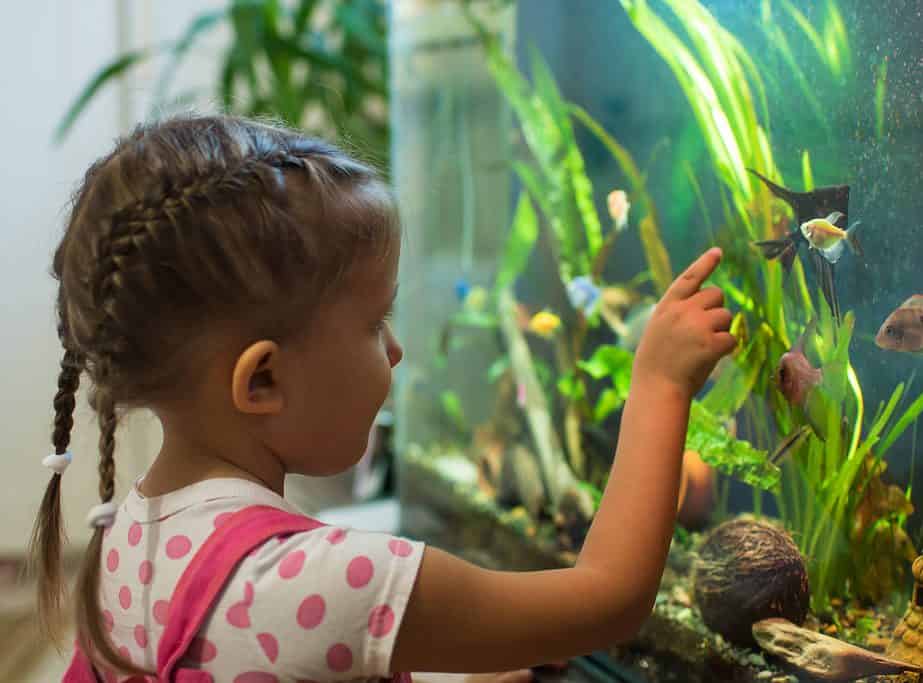
If you are looking for relatively easy-to-care-for pet fish with minimal equipment, you do have options. There are aquarium fish that can be happy and healthy at room temperature and in a small aquarium.
If you are looking for cold-water fish that are great for beginners and do well in small tanks, you have some options. Those species include Endler’s Livebearer, Clown Killifish, Bloodfin Tetras, Pygmy Sunfish, Medaka Ricefish, Asian Stone Catfish, and several species of barbs and minnows.
All fish on our list do well with other fish of similar size but it is important to match tankmates according to their optimal living conditions and diets, too. Social fish need to live with several specimens of their own.
What Is Room Temperature for an Aquarium?
Room temperature is a general and somewhat vague notion but it generally refers to water that is 65-72°F (18-22°C). Most households stay within range regularly, and the water in a tank maintains that range of temperatures without a tank heater.
Fish that thrive at room temperature are considered cold-water fish. Compared to the popular tropical kinds of fish that require a tank heater to be healthy, room temperature is chilly.
Habituation is also important, and many species of fish tolerate a range of temperatures that is close enough to room temperature.
As long as the temperature is within the recommended range, a couple of degrees above or below is not usually an issue, as long as there are no sudden changes.
A rapid temperature change is precarious for most fish, even if the temperature is still within the acceptable range.
Most pet fish adapt to gradual changes but might not breed if the temperature is not optimal. Having a larger aquarium helps slow down temperature changes and makes any change easier for any species of fish.
What Is a Small Fish Tank?
Most species of easy-to-maintain cold-water fish do best when kept in schools. They should not be kept as lone fish at all because the fish would be lonely and unhealthy.
For that reason, a small aquarium by no means implies a 1-2 gallon bowl. Even a single fish might struggle in a space that small.
A small tank for most fish that do not need a warmer generally refers to 5-20 gallons, which is quite a range for most households. This Marina aquarium kit makes tank setup easier and comes in three most popular sizes – 5, 10, and 20 gallons.
If a tank of small size is very important to your household, then it is one of the most limiting factors but you still have options.
As alluded to above, having an aquarium that is bigger than the minimum required serves as a buffer for your pet fish, as it reduces the impact of sudden changes in temperature, acidity, or hardness.
If you would like to keep more than one species of fish in the tank, the aquarium needs to be significantly larger.
Fish That Do Well in Small Tanks Without a Warmer
1. Clown Killifish (Epiplatys annulatus)
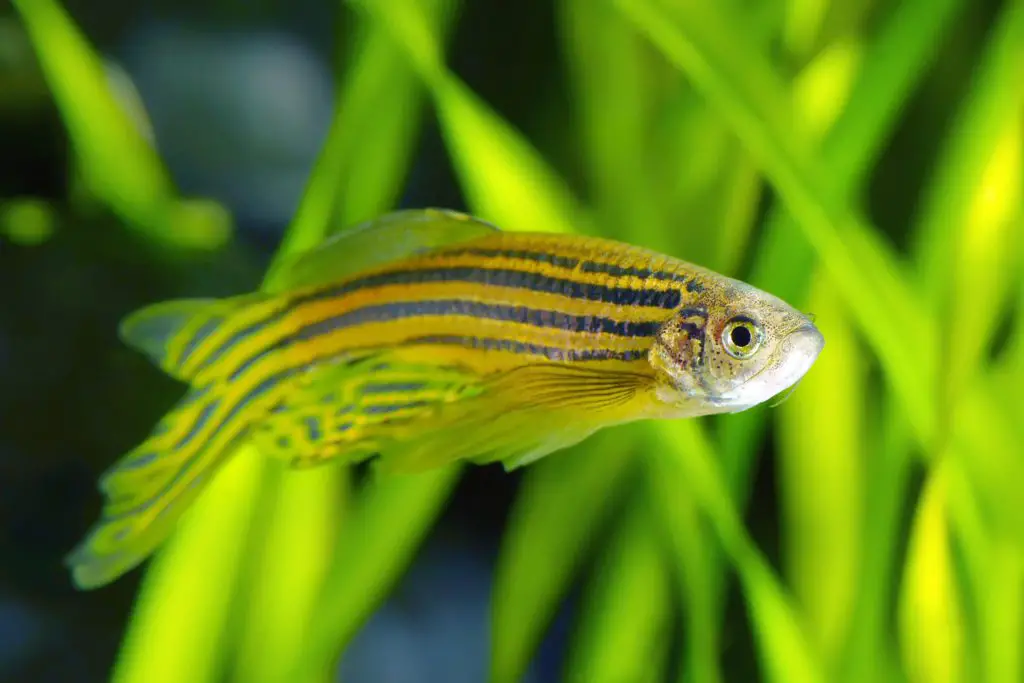
Clown Killifish descend from West Africa. They live in marches, slow-moving rivers, and ponds in their natural habitats, so it is important to keep them in still water.
If you have a bubbling filter, plants, and decorations in the aquarium could diffuse the movement of water. Frequent partial water changes are imperative to keep their tank clean enough. They also jump a lot so the aquarium needs to have a lid.
These fish eat insects in the wild, so their diet should be mostly meat-based and high in protein. Hardy and peaceful, Clown Killis are a great addition to a community aquarium. Please read our post on some of the frequently asked questions about Clown Killifish.
| Optimal water temperature: 68° – 79°F (20 – 26°C) |
| Minimum tank size: 5-10 gallons (19-38 L) for a school of 6-8 fish |
| pH: 4.0 – 7.0 |
| Lifespan: 5 years |
| Adult size: 1.2-1.5 in (3-3.5 cm) |
| Diet: carnivore |
Clown killifish are very sociable and do well with other peaceful small fish. Minnows, in particular, tend to do well with them.
2. White Cloud Mountain Minnow (Tanichthys micagemmae)
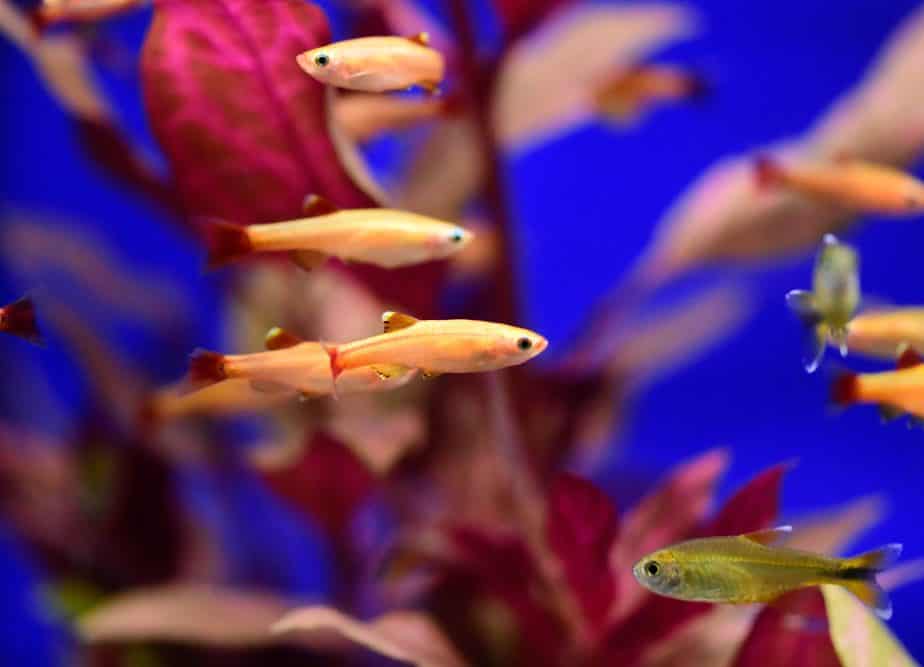
White Cloud Mountain Minnows come from China and there has been a dramatic drop in their population in the wild due to the disruption of their natural habitat. These fish are currently considered threatened. Efforts are underway, however, to solidify their presence in nature.
Similar to neon tetras in looks and many aspects of care, these fish are even better for novice fish owners because their needs are not as specific as those of tetras.
White Cloud Mountain Minnows are very sociable and should be kept in schools of at least 5-6. They also get along well with other peaceful fish of a similar size. Avoid placing them together with territorial species of fish. In theory, goldfish could get along with minnows but, due to the difference in size, goldfish could inadvertently swallow their tiny tankmates.
Although minnows should not live in water colder than 60°F (15°C) regularly, they do tolerate a gradual decrease in temperature for a few degrees, as long as it returns to the baseline within a couple of days.
| Optimal water temperature: 64-72°F (18-22°C) |
| Minimum tank size: 10 gallons (38 L) for a small school of 5-6 |
| pH: 6.0-8.0 |
| Lifespan: 3-5 years |
| Adult size: 2 in (5 cm) |
| Diet: omnivore |
3. Endler’s Livebearer (Poecilia wingei)
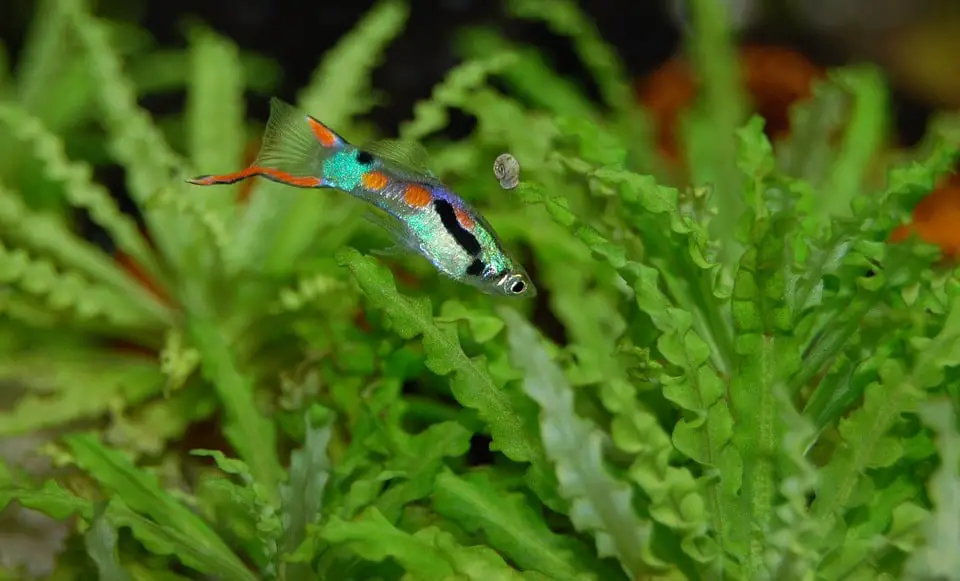
Endler’s Livebearer hails from Venezuela and is also an endangered species. They are sometimes called Endler’s guppies because they often breed with guppies.
These fish are pretty to look at, with their patches of many colors, and are fairly straightforward to care for. They do, however, need more spacious aquariums than most of the other fish on our list.
| Optimal water temperature: 64-82°F (18-28°C) |
| Minimum tank size: 20 gallons (76 L) for a school of 4-6 fish |
| pH: 5.5-8.0 |
| Lifespan: 2-3 years |
| Adult size: 1.5-2 in (3.5-5 cm) |
| Diet: omnivore |
4. Bloodfin Tetra (Aphyocharax anisitsi)
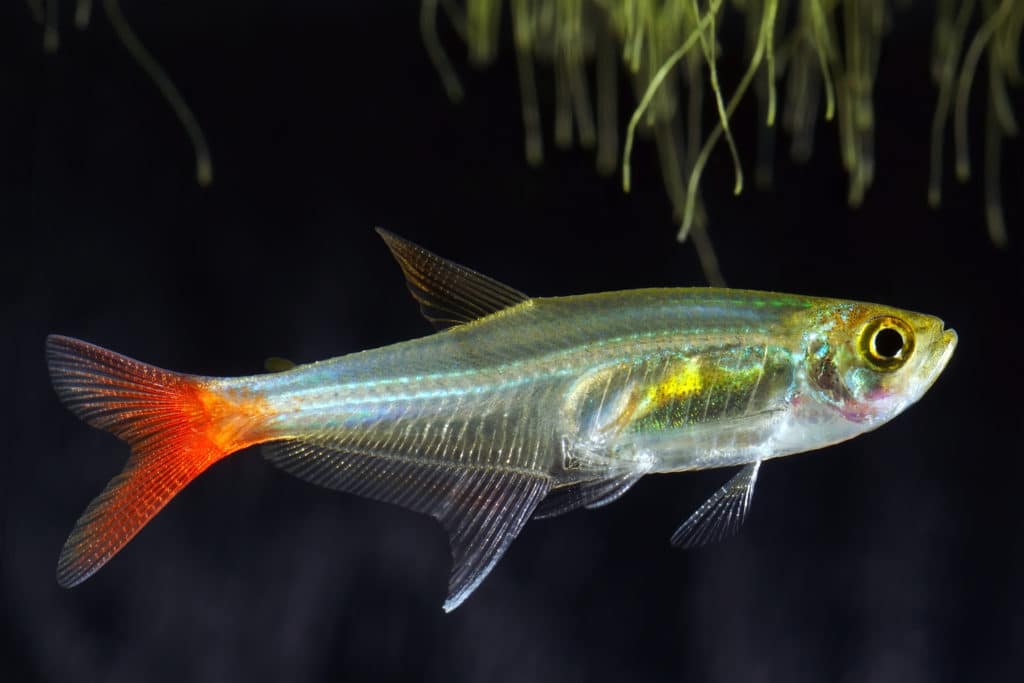
Spectacular Bloodfin Tetras originate in South America and are some of the hardiest fish, so they are a great species for a new fish owner.
Bloodfin Tetras are prone to nipping the fins and tails of their tankmates so it is best to avoid putting them in the same aquarium with fish with luxurious fins. They do well with other species of tetras, as long as the other species do well in water at room temperature, too.
| Optimal water temperature: 64 – 82°F |
| Minimum tank size: 10 gallons (38 L) for a school of 5-6 fish |
| pH: 6.0 – 8.0 |
| Lifespan: 5 – 8 years |
| Adult size: 2 in (5 cm) |
| Diet: omnivore |
5. Rosy Red Minnow (Pimephales promelas)
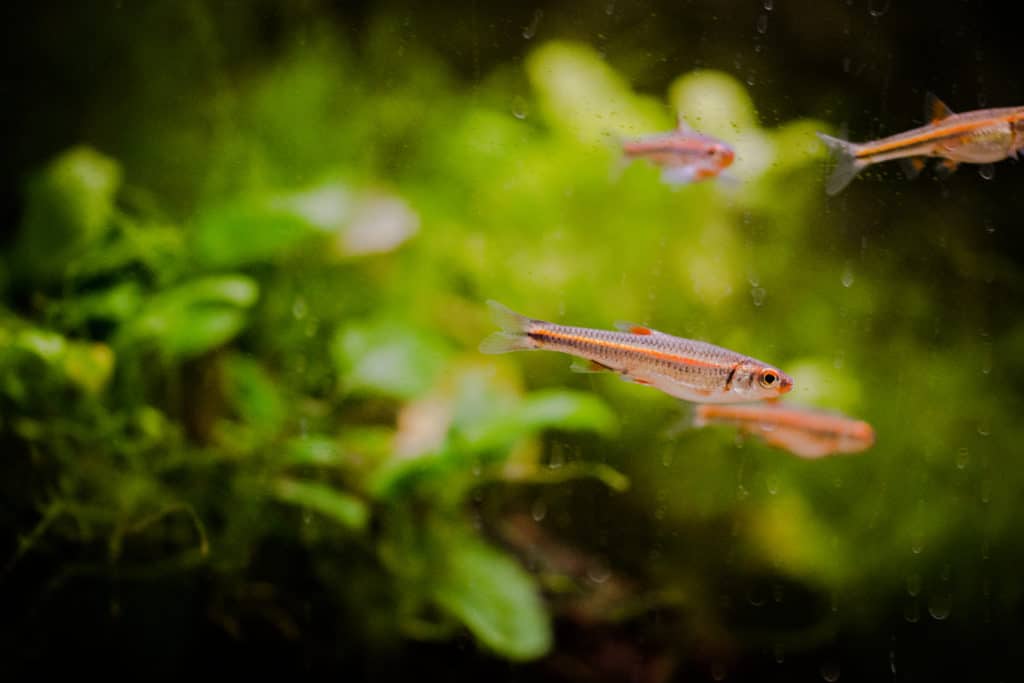
These freshwater fish are found in watersheds all over North America. They are a sturdy species that does well in slow-moving muddy waters with low oxygen content. They do tolerate fluctuations in acidity and salt content but it is best to keep their environment stable to promote longevity.
Rosy Red Minnows are sociable and rarely show aggression toward other fish.
They do like to hide for periods of rest so it is important to provide them with some decorations or plants in their aquarium.
| Optimal water temperature: 50 – 78°F (10 – 25°C) |
| Minimum tank size: 10 gallons (38 L) for 5 – 6 fish |
| pH: 7.0 – 8.0 |
| Lifespan: 2 – 4 years |
| Adult size: 2-3 in (5 – 7.5 cm) |
| Diet: omnivore |
6. Asian Stone Catfish (Hara jerdoni)
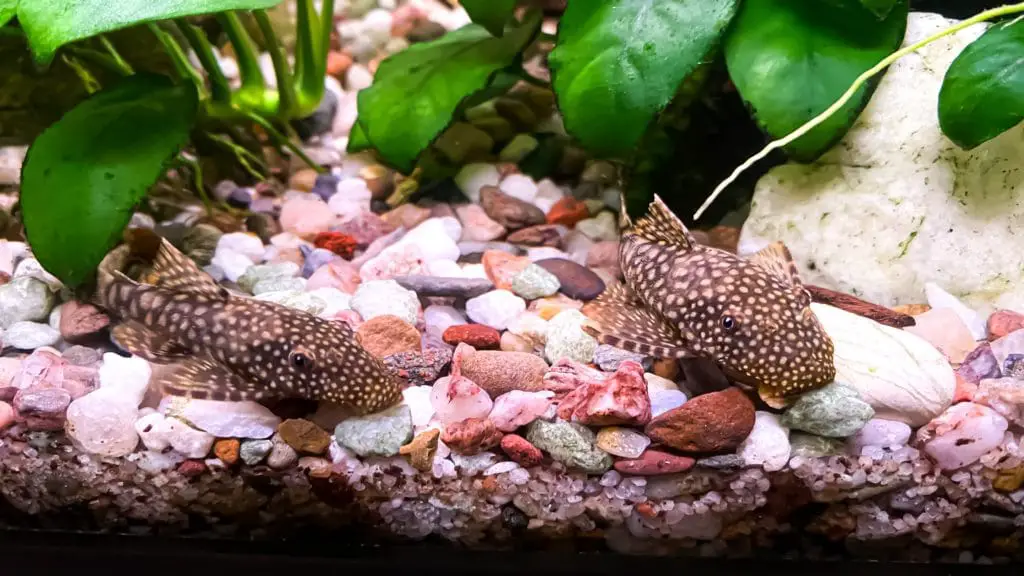
These peculiar-looking fish live in the slow-moving waters of South Asian rivers and ponds. They are timid, peaceful, and nocturnal for the most part. Asian Stone Catfish get along with most friendly fish of a similar size and are not picky with their food.
These fish could be quite inconspicuous in the aquarium because they are not very playful and are less active during the day. They have lower requirements for space than most fish and make excellent community pet fish.
| Optimum water temperature: 64 – 75°F (18° – 24°C) | |
| Minimum tank size: 5-10 gallons (16.5- 38 L) for a school of 4-5 fish | |
| pH: 5.6 – 7.6 | |
| Lifespan: 3-5 years | |
| Size: 1-2 inches (2.5-5cm) | |
| Diet: omnivore, high protein, mostly meat-based |
7. Pygmy Sunfish (Elassoma evergladei)
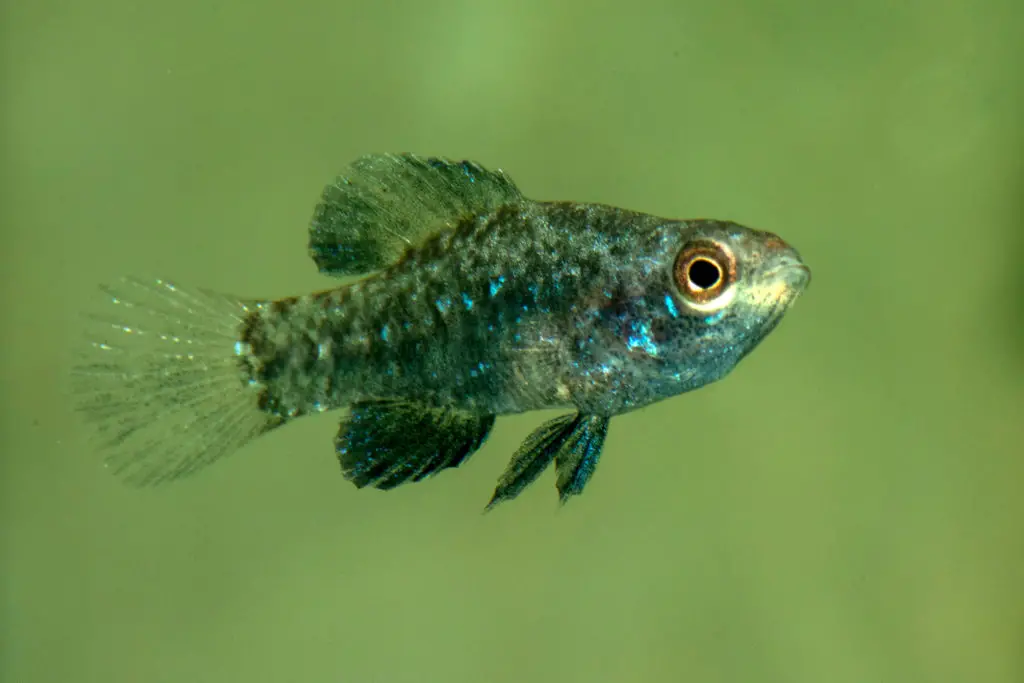
These adaptable and undemanding fish live in the south and the southeast USA in their natural habitats.
Pygmy Sunfish do fine with having just two fish of this species in a tank although a bigger tank and more fish of the same kind is best.
Pygmy Sunfish mostly eat insects in their natural habitats, so these pets’ diets should be high in protein. They do, however, eat plant-based food too. Interestingly, although Pygmy Sunfish are low-maintenance and hardy, they are somewhat picky about their food. Specifically, they like live or frozen foods but not the typical pellet fish food.
| Water temperature range: 50° – 86° F (10° – 30° C) | |
| Minimum tank size: 10 gallons (38 L) for a school of 4-6 fish | |
| Ph: 6.0 – 7.5 | |
| Lifespan: 2 – 3 years | |
| Adult size: 1 – 1.5 in (3 – 4 cm) | |
| Diet: omnivore |
8. Gold Barb (Puntius semifasciolatus)
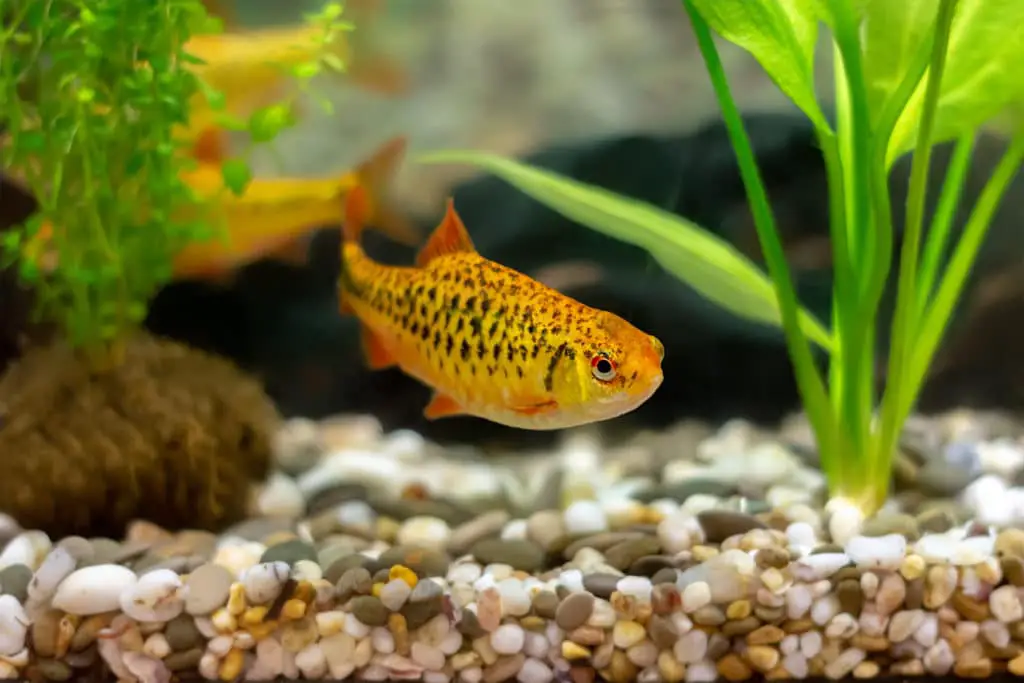
Very easy to care for and tolerant of colder, free-flowing, well-oxygenated water, Gold Barbs are a hardy species of fish for your ideally quite spacious tank. In good conditions, they can grow up to be quite long, which is why a small school needs at least 20 gallons of water to be happy.
Gold Barbs are classic omnivores and they appreciate most forms of plant-based and meat-based food.
| Optimum water temperature: 64 – 75° F (18 – 24° C) | |
| Minimum tank size: 20 gallons (76 L) for a small school | |
| pH: 6.0-8.0 | |
| Lifespan: 5 years | |
| Adult size: up to 3 inches (7.5 cm) | |
| Diet: omnivore |
9. Medaka Ricefish/ Japanese Ricefish (Oryzias latipes)
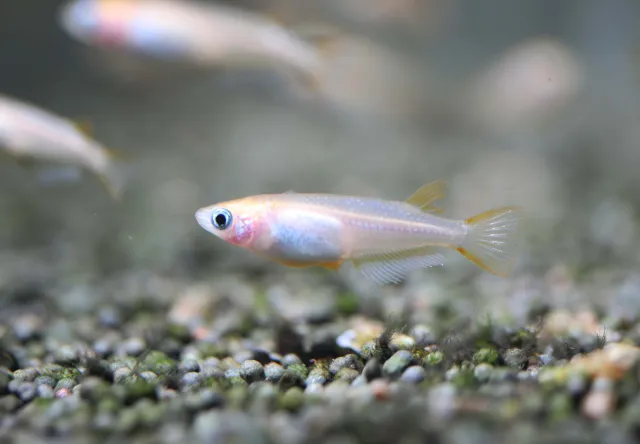
Medaka, also known as Japanese ricefish, comes from East and South-East Asia. They are still relatively rare outside of Asia but, for those who have already discovered these fish, they make great pet fish for novice owners and community aquariums.
Japanese ricefish are docile, very hardy, and quite easy to care for. Japanese ricefish are very hardy, they are some of the easiest fish to breed for a novice.
They must live in at least a small school of their kind (6 or more fish) but they adapt well to changes in their environment. Medaka fish do very well with other peaceful fish and welcome both meat-based and plant-based diets. They love having a dark substrate in their tanks.
As a bonus, these dainty fish are active and fun to observe, so they are a good species for new fish owners and households with children.
| Optimum water temperature: 64° – 75° F (18° – 24° C) |
| Minimum tank size: 10 gallons (38 L) for a school of 6 |
| Ph: 7.0-8.0 |
| Lifespan: 2 years |
| Adult size: 1.6 inches (4 cm) |
| Diet: omnivore |
10. Zebra Danio, aka Zebrafish (Danio rerio)
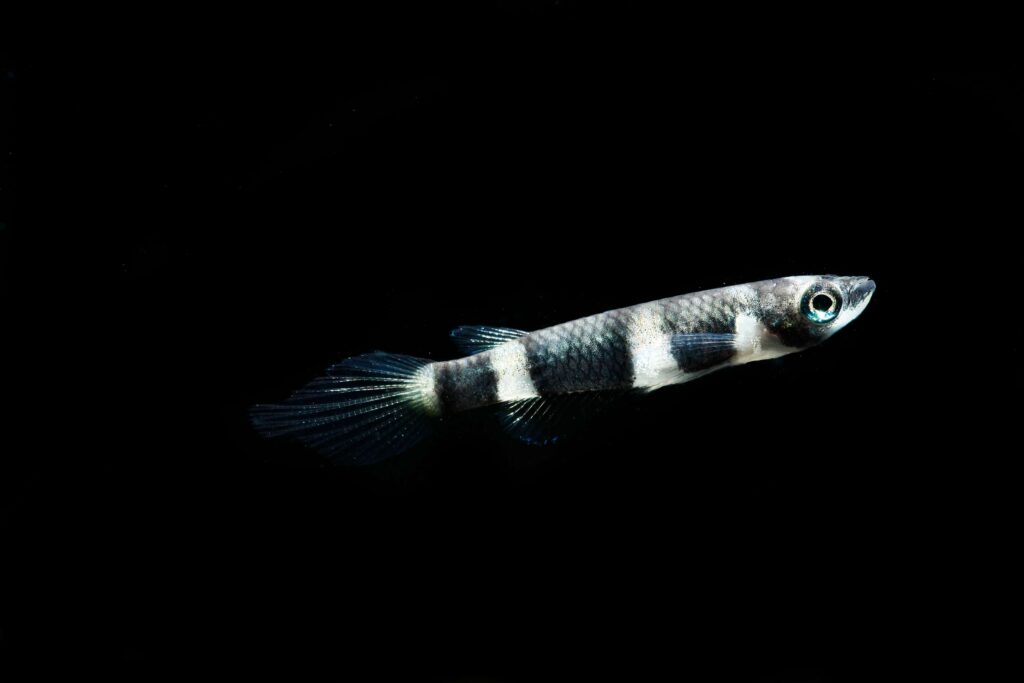
These conspicuous fish do best in schools of 6 or more. They are quite friendly but tend to be fin nippers, so they should not be kept with species that have long wavy fins, such as bettas or angelfish.
Zebrafish are highly active, playful, and known to chase each other around the tank. Although they do fine in smaller tanks, they do benefit from and show off their lively character in spacious aquariums.
Zebra danios come from South Asia and they thrive in slow-moving environments in their natural habitats. Use decorations or plants in your aquarium to diffuse movement from a bubbling filter if your aquarium has one.
| Water temperature range: 64 – 74° F (18 – 24° C) | |
| Minimum tank size: 10 gallons (38L) for a small school of 6 | |
| Ph: 6.5 – 7 | |
| Lifespan: 5 years | |
| Adult size: 2 inch | |
| Diet: omnivore |
Related Question:
Do I Need To Change The Water In A Filtered Tank?
In general, you should regularly replace the water in your aquarium, even if it has a good filter installed. Any given filter does not take care of all aspects of cleaning. You have to remove nitrate from the tank and that is accomplished by replacing water. Removing some of the waste also prevents the filtration system from getting overwhelmed and you have to do less maintenance of your filter.
Recent Posts
Classic Oryzias latipes specimens are of beautiful silver color but these fish come in many hues and colors in the wild and captivity. You might wonder if specimens of different colors and with...

